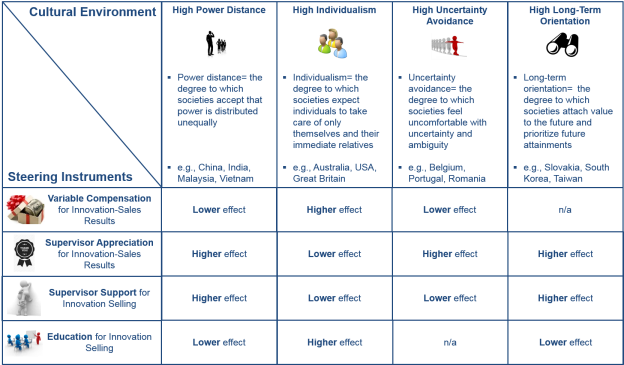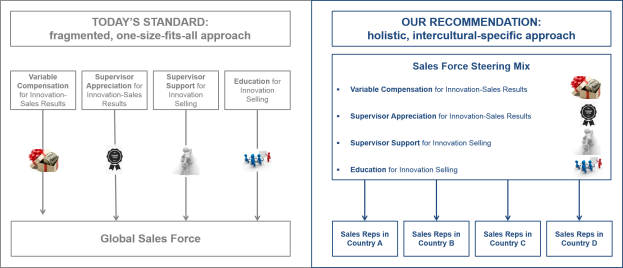The commercialization of innovations is the lifeblood for most organizations. However, bringing new products successfully to market can be a complex and difficult challenge, especially if your company operates in a business-to-business (B2B) environment. The sales force is often the dominant sales channel, and it can be a potential bottleneck in the route to market of innovations. That is why it is especially important for B2B firms to direct and guide their sales forces for successful innovation selling.
This task can prove quite difficult, especially since many sales reps have a low initial motivation for innovation selling. This is mainly due to three major reasons:
- First, new products are often complex and difficult to understand. Therefore, salespeople need to invest a considerable amount of time in order to fully grasp the new products and their additional benefit for the customer.
- Second, sales reps are often uncertain about the functionality and reliability of new products: Will the new features and technologies work out as promised? In fact, salespeople represent the “first line of customers” for new products, often equipped with profound skepticism towards novel solutions.
- Third, many salespeople fear jeopardizing good client relationships with new products. They do not want to be held responsible for the latest gadget’s “teething problems” or even serious functional flaws and put their client base at risk.
In our recent article “Motivating Sales Reps for Innovation Selling in Different Cultures” in the Journal of Marketing, we report results on how firms can enhance reps’ innovation commercialization in a broad international context. Specifically, to examine this issue, we collected data from 406 sales reps from an international B2B supplier. These salespeople represent 38 countries on four continents. Consequently, this investigation delivers one of the most far-reaching international studies in sales research.
The study’s results demonstrate that firms should employ specific steering instruments in order to motivate their sales reps for innovation selling. Most importantly however, we find that these sales force steering instruments should closely correspond with reps’ cultural imprint in terms of Hofstede’s four dimensions: power distance, individualism, uncertainty avoidance, and long-term orientation (you may want to take a glimpse at https://geert-hofstede.com/ for more detailed information on Hofstede’s research on cultures).
For instance, we find that the total effect on financial innovation performance surges by more than 350% when firms apply variable compensation for innovation-sales results in highly individualistic (vs. less individualistic) cultures. Moreover, we demonstrate that innovation performance may increases by more than 300% when supervisor appreciation for innovation-sales results is applied in cultures with high power distance (vs. low power distance). Strikingly, we find that the average variation of all steering instruments’ effects across high versus low values for each cultural dimension is greater than 100%. These large percentage numbers illustrate the huge leverage of intercultural sales force steering regarding innovation commercialization.
In the following table we display an overview of our main findings. You might want to challenge your own company’s steering approach: Do your steering instruments actually match with the cultural environment they are applied in?
 To enhance your firms’ innovation commercialization through intercultural sales force steering, we recommend three specific actions. Implementing these recommendations may help your company to exploit these large potentials:
To enhance your firms’ innovation commercialization through intercultural sales force steering, we recommend three specific actions. Implementing these recommendations may help your company to exploit these large potentials:
- Adapt your sales force steering approaches to cultural environments
Many companies around the globe today harmonize their sales force steering in the course of globalization as, for example, when implementing one-size-fits-all approaches derived from corporate strategy. However, this study’s results lead us to warn you against overly meshing sales force steering across countries. Instead, we recommend looking carefully at the markets and cultures you operate in and focus on the most effective steering instruments per cultural context. In doing so, you will be able to most efficiently and effectively motivate your sales reps for innovation selling and see a strong performance. For instance, think about flexible steering approaches and heterogeneous incentive plans that have globally standardized elements but also allow for adaptation to cultural peculiarities.
- Develop a more comprehensive approach to sales force steering
Does the following sound familiar to you? Your firm has many autonomous units that are involved in sales force steering challenges. For instance, there is the compensation division that takes care of financial incentive plans, while the benefits division is responsible for non-monetary incentives. Then, there is global HR that schedules on-the-job trainings and finally the sales supervisors, who make use of on-the-job instruments to motivate their salespeople. However, in contrast to this fragmented common practice, we strongly recommend orchestrating these different sales force steering approaches to systematically align and make use of the entire range of steering instruments. We briefly outline in the figure below how such an integrated intercultural sales force steering approach could look like.

- Segment your sales force according to their cultural imprint to customize your sales force steering approach
Finally, we recommend segmenting sales reps according to their cultural imprint in order to specifically tailor sales force steering instruments to enhance innovation commercialization. Specifically, you might classify the sales force in terms of power distance, individualism, uncertainty avoidance, and long-term orientation. To motivate innovation selling by sales reps from cultures with high power distance (e.g., Brazil, China, India), we recommend to focus on steering measures that involve close interaction with the direct supervisor, such as supervisor appreciation for innovation-sales results. In contrast, for sales reps from individualistic cultures (e.g., Netherlands, United Kingdom, United States), we recommend a focus on steering measures that reward or foster individual attainments, such as education for innovation selling or variable compensation for innovation-sales results. For sales reps from cultures with high long-term orientation (e.g., Slovakia, South Korea, Taiwan) as well as for sales reps from uncertainty-avoidant cultures (e.g., Belgium, Portugal, Romania), we advise focusing on supervisor appreciation for innovation-sales results.
For more detailed information and in-depth discussion of our study please refer to the original article published in the Journal of Marketing: http://dx.doi.org/10.1509/jm.14.0398
Sebastian Hohenberg and Christian Homburg (2016) Motivating Sales Reps for Innovation Selling in Different Cultures. Journal of Marketing: March 2016, Vol. 80, No. 2, pp. 101-120.
________________________
 Christian Homburg is Director of the Institute for Market-Oriented Management (IMU) at the University of Mannheim (Germany). His special subjects are sales management, customer relationship management, and market-oriented management. Dr. Homburg has published numerous books and articles at the national as well as the international level. Today, he is member of the editorial boards of 6 scientific journals in the United States and Germany. Furthermore, since April 2011, he operates as the first German area editor for the Journal of Marketing. Prior to his academic career, Dr. Homburg was director of marketing, controlling and strategic planning in an industrial company that operates globally. In addition to his academic position, he is chairman of the scientific advisory committee of Homburg & Partner, an international management consultancy.
Christian Homburg is Director of the Institute for Market-Oriented Management (IMU) at the University of Mannheim (Germany). His special subjects are sales management, customer relationship management, and market-oriented management. Dr. Homburg has published numerous books and articles at the national as well as the international level. Today, he is member of the editorial boards of 6 scientific journals in the United States and Germany. Furthermore, since April 2011, he operates as the first German area editor for the Journal of Marketing. Prior to his academic career, Dr. Homburg was director of marketing, controlling and strategic planning in an industrial company that operates globally. In addition to his academic position, he is chairman of the scientific advisory committee of Homburg & Partner, an international management consultancy.
 Sebastian Hohenberg is Assistant Professor at the Marketing Department of the University of Mannheim (Germany). He also works as a freelance consultant at Homburg & Partner, an international consultancy agency. During his research and consultancy projects, Dr. Hohenberg focuses on topics in the areas of sales management and innovation management.
Sebastian Hohenberg is Assistant Professor at the Marketing Department of the University of Mannheim (Germany). He also works as a freelance consultant at Homburg & Partner, an international consultancy agency. During his research and consultancy projects, Dr. Hohenberg focuses on topics in the areas of sales management and innovation management.




Sebastian: thank you for posting a well-researched and thought provoking article. There are some variables that should be considered, and I am not sure if your research included them:
1. average product life cycle in the industry
2. competitive position of the innovating company
3. pre-introduction engineering and testing rigor applied to products
Your point that Sales can be a bottleneck is well taken. But in my experience, the sales organization can also facilitate a fast-track into the market. When I sold Auto-ID products and services (barcoding and RFID), my company was woefully behind in their development of a full MS-DOS operating system in a handheld device. Competitors had that offering many months before, and we were getting clobbered trying to sell our limited-function devices with a proprietary operating system – especially in larger deals.
Once the new product became available, the sales force immediately sold it. No reticence. No coaxing. No special commission or incentive structure. There was a little ramp time needed to understand the technical features, but no time needed for the more difficult challenge of understanding the customer issues. The salesforce was already painfully aware of all of them. In this case, the product introduction was highly successful because it “leapfrogged” the competition – as commonly happens in tech. Sales was certainly not an impediment, but rather a fast-track.
Other products my company manufactured were not as successful in their product launch. For example, a when a particular barcode printer model was introduced, it sold poorly because it was priced too high and was horribly complicated to configure and use compared to the company’s other models. As you point out, when a product takes too much time to sell, the sales force won’t give it attention. No amount of incentive realignment could have compensated for the product’s poor adoption rate.
To a large extent, I think that’s as it should be. Companies can try to “goose” or artificially increase a product’s demand by offering very high commissions or “spiffs,” but in the end, I question whether the numbers that come back from the field give management false confidence regarding product appeal, or, more importantly, really provide customers with a solution that’s more valuable for them.
Dear Andy,
Thank you very much for the detailed comments on our research report. In the following, we organize our responses according to the three key issues that you have raised.
[1] Is the sales force a fast track to innovation commercialization?
The sales force operates at the interface between the company and the customers. Prior research calls this interface “the bottleneck” in a neutral descriptive way – a term that we adopt above to emphasize the importance of this interface. Accordingly, sales reps’ behaviors may facilitate and/or complicate the adoption decisions of customers. Therefore, as you have pointed out, if sales reps “buy-in” into new solutions, this can substantially speed up the diffusion of innovations. Thank you for making us aware how the wording “bottleneck” may be perceived by the reader and for the examples, which nicely highlight the fast-track potential of the sales force!
[2] (How) should firms motivate their sales reps for innovation selling?
In response to your concerns regarding artificially increasing product demands through innovation-oriented sales force steering, we want to emphasize two points:
First, sales force steering and new product development represent important and complementary decision fields for firms to improve their innovation success. Specifically, when asking for the reasons why innovations fail, the responses we get differ substantially by the respondents’ functions. For instance, when investigating salespeople, the stated top failure reasons usually relate to low “benefit-to-price ratios” or the “lack of functionality,” whereas R&D employees or product managers generally focus on “a lack of frontline buy-in or motivation.” In contrast, rich empirical evidence indicates that the reasons for innovation success/failure are diverse and multifactorial (and the truth probably lies somewhere in-between). Thus, we agree that sales force steering cannot replace the need for developing valuable customer solutions. However, we also want to stress that good product development cannot replace the need for innovation-oriented sales force steering.
Second, we often learn from the sales reps we talk to that selling innovations requires a lot more effort and that this “extra-effort” should somehow be acknowledged by companies. To do this, our findings – in line with prior research in this area – show that firms can use financial instruments (e.g., amend the existing incentive scheme to include innovation-oriented KPIs) or nonfinancial steering instruments (e.g., trainings, personal appreciation, and supervisor support). Applying these instruments – per our experience – is an important approach for firms to acknowledge and reward sales reps’ efforts (and does not relate to artificially increasing demands). In addition, the study’s findings show that the effectiveness of financial and nonfinancial steering instruments strongly varies by sales reps’ cultural imprint (this is actually the main novel finding of this study).
[3] What was our research context/ which variables did we include?
Thank you for suggesting three variables that may influence firms’ innovation commercialization. In response to your comment, we want to emphasize that we have included a variety of sales rep factors and environmental factors in our model, since these two variable domains generally shape individuals’ task-specific motivation (as a broad literature stream in psychology demonstrates). To see the complete list of variables that we have included, please refer to Table 5 in our original article (you may follow the link above). Moreover, the choice of variables is, of course, also shaped by our research design. Specifically, to test the hypotheses, we collaborated with a global B2B chemical supplier. Overall, we believe that the study’s findings generalize to various B2B settings, since chemical-sales shares many attributes with other B2B industries. However, this research design (i.e., a single firm design) makes it impossible/not meaningful to model various company and industry factors, as you have suggested.
Again, thank you very much for your comments and suggestions. We appreciate your feedback and hope that you find our responses helpful.
Hi Sebastian: thank you for your detailed response, which clarifies some of my questions. My observations and comments have been developed through field experience in B2B sales of technology products and services, so my purpose is to describe where your research doesn’t comport with my experience, and not to suggest that there are flaws in your survey or assumptions.
First, I agree with your fundamental finding that efficacy of sales incentives vary with culture – a conclusion I also developed through sales training I provided in several countries for a global software developer. While end-customer business challenges were quite consistent in Canada, India, South Africa, Israel, and Trinidad, the sales forces I worked with were markedly different in their compensation structures.
But in other areas, my experience has been very different. Today, Sales operates at an interface between a company and its customers.- A crucial one, though some would argue, one of diminishing importance and value. This semantic distinction represents a profound change from just a couple of decades ago when for many companies, Sales was the interface. CRM and the suffusion of customer information throughout the organization has much to do with this development. So for many (not all!) companies, Sales is just one of several vendor-customer interfaces. That change makes the mission of driving technology adoption not just a Sales issue, but an organizational issue. Many companies overlook this development altogether. Once product engineering has completed prototype testing for a new product, the company mistakenly places the entire onus of selling it on the sales force.
Second, I have found that when salespeople are slow to adopt selling new products and services, the problem has been overwhelmingly self-correcting: “refusers” don’t stay that way for long. They either adopt, or they quickly fall substantially below quota, and are churned from field sales. At least in US IT sales, I haven’t seen salespeople last long depending on their ephemeral legacy system cash cows.
In fact, in my experience, it’s quite rare to see product sales leading the innovation charge, and dragging the sales force along. In the technology sectors where I have been active, the sales force has been a key force in the effort to innovate. I have participated in sales meetings too numerous to count where the salespeople have (literally) pounded their fists on the table demanding product improvements where more nimble competitors were eating their lunch in deals large and small. So many times, in fact, that management’s pushback has become painfully cliche. “Sell what we’ve got!” and “We’ll never have the most innovative products, so you need to figure out other ways . . .”
Finally, I appreciate the idea to extrapolate the findings in one industry into other B2B sales environments. I do this too. But I think it’s hard to extend what happens in the chemical industry, where products are consumable, to other B2B sales where capital goods are involved. CapEx opportunities typically involve very different buyers and buying motivators, and are subject to different forces such as the cost of capital.